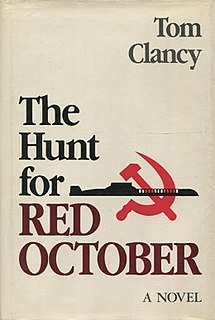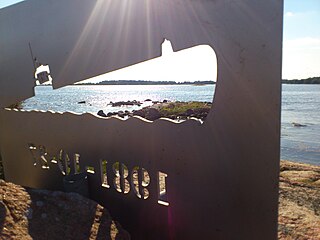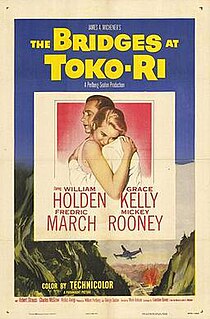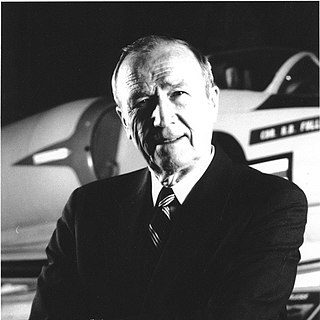
The Hunt for Red October is the debut novel by Tom Clancy, first published on October 1, 1984 by the Naval Institute Press. It depicts Soviet submarine captain Marko Ramius as he seemingly goes rogue with his country's cutting-edge ballistic missile submarine Red October, and marks the first appearance of Clancy's most popular fictional character Jack Ryan, an analyst working for the Central Intelligence Agency, as he must prove his theory that Ramius had intended to defect to the United States. The book was loosely inspired by the mutiny on the Soviet frigate Storozhevoy in 1975.

The Royal Naval Reserve (RNR) is one of the two volunteer reserve forces of the Royal Navy in the United Kingdom. Together with the Royal Marines Reserve, they form the Maritime Reserve. The present RNR was formed by merging the original Royal Naval Reserve, created in 1859, and the Royal Naval Volunteer Reserve (RNVR), created in 1903. The Royal Naval Reserve has seen action in World War I, World War II, the Iraq War, and War in Afghanistan.

USS Pueblo (AGER-2) is a Banner-class environmental research ship, attached to Navy intelligence as a spy ship, which was attacked and captured by North Korean forces on 23 January 1968, in what is known today as the "Pueblo incident" or alternatively, as the "Pueblo crisis".

Soviet submarine S-363 was a Soviet Navy Whiskey-class submarine of the Baltic Fleet, which became notable under the designation U 137 when it ran aground on 27 October 1981 on the south coast of Sweden, approximately 10 km (6.2 mi) from Karlskrona, one of the larger Swedish naval bases. U137 was the unofficial Swedish name for the vessel, as the Soviets considered names of most of their submarines to be classified at the time and did not disclose them. The ensuing international incident is often referred to as the Whiskey on the rocks incident.

The Bridges at Toko-Ri is a 1954 American war film about the Korean War and stars William Holden, Grace Kelly, Fredric March, Mickey Rooney, and Robert Strauss. The film, which was directed by Mark Robson, was produced by Paramount Pictures. Dennis Weaver and Earl Holliman make early screen appearances in the motion picture.

The Bedford Incident is a 1965 British-American Cold War film starring Richard Widmark and Sidney Poitier and co-produced by Widmark. The cast also features Eric Portman, James MacArthur, Martin Balsam and Wally Cox, as well as early appearances by Donald Sutherland and Ed Bishop. The screenplay by James Poe is based on the 1963 book by Mark Rascovich, which borrowed from the plot of Herman Melville's Moby-Dick; at one point in the film, the captain is advised he is "not chasing whales now".

Charles Butler McVay III was an American naval officer and the commanding officer of the cruiser USS Indianapolis when she was lost in action in 1945, resulting in a significant loss of life. Of all captains in the history of the United States Navy, he is the only one to have been subjected to court-martial for losing a ship sunk by an act of war, despite the fact that he was on a top secret mission maintaining radio silence. After years of mental health problems, he took his own life aged 70 years. Following years of efforts by some survivors and others to clear his name, McVay was posthumously exonerated by the 106th United States Congress and President Bill Clinton on October 30, 2000.

The Union Navy was the United States Navy (USN) during the American Civil War, when it fought the Confederate States Navy (CSN). The term is sometimes used carelessly to include vessels of war used on the rivers of the interior while they were under the control of the United States Army, also called the Union Army.
Francis Cogswell was a captain in the United States Navy who served in World War I and was a Navy Cross recipient.

Thomas Jerome Hudner Jr. was an officer of the United States Navy and a naval aviator. He rose to the rank of captain, and received the Medal of Honor for his actions in trying to save the life of his wingman, Ensign Jesse L. Brown, during the Battle of Chosin Reservoir in the Korean War.
Hispanics in the United States Navy can trace their tradition of naval military service to men such as Lieutenant Jordi Farragut Mesquida, who served in the American Revolution. Hispanics, such as Seaman Philip Bazaar and Seaman John Ortega, have distinguished themselves in combat and have been awarded the Medal of Honor, the highest military decoration of the United States. Hispanics have also reached the top ranks of the navy, serving their country in sensitive leadership positions on domestic and foreign shores. Among those who have reached the highest ranks in the navy are Commodore Uriah Phillips Levy, of Sephardic and Ashkenazic Jewish descent, who participated in the War of 1812 as an assistant Sailing master; Admiral David Glasgow Farragut, for whom the rank of admiral in the U.S. Navy was created during the American Civil War; and Admiral Horacio Rivero, who led the navy during the Cuban Missile Crisis.

Gerald Francis Bogan was a United States Navy aviator and vice admiral who served in World War I and II.

Vincent Paul de Poix was a vice admiral in the United States Navy. He began his career as a naval aviator and fighting in World War II aboard USS Enterprise (CV-6). A graduate of the United States Naval Academy, he became the first captain of the newly commissioned USS Enterprise (CVN-65) in November 1961. He later participated in the Vietnam War, and commanded the United States Second Fleet. He was Director of the Defense Intelligence Agency from August 1972 to September 1974.

Bert Mizusawa is a retired major general in the United States Army, serving in the Army from 1979 to 2015. Mizusawa also served in the United States Senate as a professional staff member and as a Senior Executive in the Pentagon, making him one of only a handful of individuals to serve at flag rank in the military as well as in both the legislative and executive branches. Mizusawa is also an attorney and is admitted to the bars of New York, the District of Columbia, Virginia and the United States Supreme Court.
Vice-Admiral Sir John Gilchrist Thesiger Inglis,, sometimes known as Tommy Inglis, was a Royal Navy officer who served as Director of Naval Intelligence from 1954 to 1960. In this capacity, he attempted to cover-up the "Buster Crabb affair" in 1956.

Henry Croskey Mustin was a pioneering naval aviator who undertook the auspicious task of establishing the first Naval Aeronautic Station on the site of the abandoned Navy Yard at Warrington, Florida in 1914. He was designated Navy Air Pilot No. 3 and later Naval Aviator No. 11. Two U.S. Navy destroyers have borne the name Mustin in honor of Captain Mustin and his descendants, three of whom have served as flag officers.

In the United States Navy, United States Coast Guard, United States Public Health Service Commissioned Corps (USPHS), and National Oceanic and Atmospheric Administration Commissioned Officer Corps, captain is the senior-most commissioned officer rank below that of flag officer. The equivalent rank is colonel in the United States Army, Air Force, and Marine Corps.
Admiral Sir Sidney Robert Bailey, was a Royal Navy officer who became President of the Royal Naval College, Greenwich.

Donald D. Engen was a United States Navy vice admiral, former Administrator of the Federal Aviation Administration (FAA) and former Director of the National Air and Space Museum.














